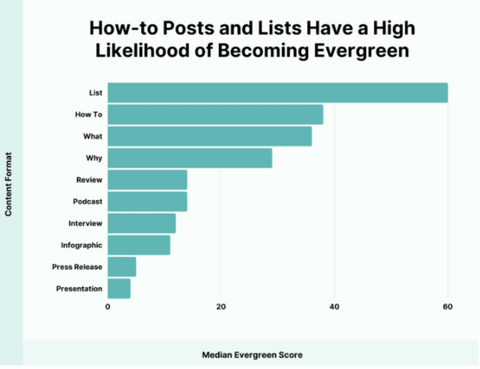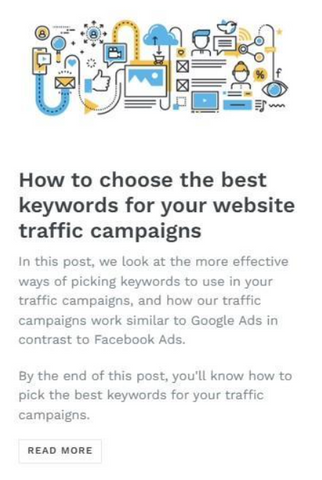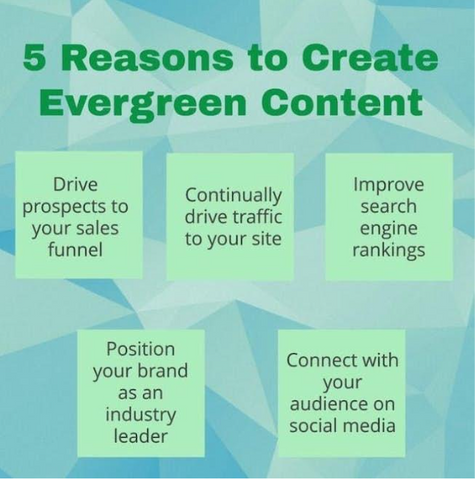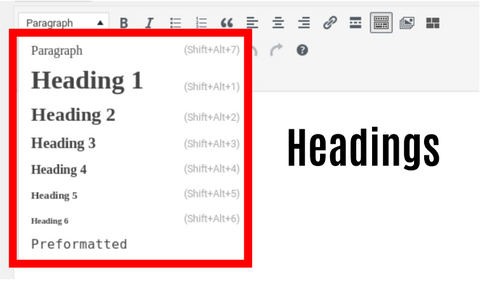Table of Contents
Introduction
Evergreen Content: What Is It?
Standard Evergreen Formats
How to Make a Blog Post or Article Evergreen
Evergreen Content Examples
Regularly update evergreen content
How to keep your content relevant throughout time
Achieving Success Doesn't Rely Only on Evergreen Content
Conclusion
Content marketing is a massive part of digital marketing and will only become more critical in the coming years. One of the most important aspects of content marketing is creating evergreen content. Evergreen content is the kind of content that remains relevant and useful for a long time. It's the kind of content that people will want to read, share, and link to long after it's been published. There are many ways to create evergreen content, but some of the most effective strategies include comprehensive guides, step-by-step tutorials, and in-depth case studies.
If you're looking to create evergreen content that will help you promote your business in 2022 and beyond, this guide will give you everything you need to get started.
Evergreen Content: What Is It?
Evergreen content is material that remains relevant and useful over time. This content can be helpful for months or even years after publication. It's the polar opposite of timely content, which has a brief shelf life and quickly becomes outdated.
You might believe that all internet content is persistent because a blog post doesn't simply vanish when published. However, evergreen material is distinct. It is still relevant long after its publication date, and search traffic has increased over time. Did you know? Hubspot has doubled its monthly leads and has observed an average 106 % increase in organic search views by updating old posts and making them evergreen content.
Standard Evergreen Formats
Did you know? The content types that tend to become evergreen most frequently are list and how-to posts.

The following are some typical evergreen formats you might think about developing:
- Listicles
Listicles are a type of article presented in the form of a list. They are well-liked because they are simple to read and provide information that can be absorbed quickly. When done well, listicles can be an effective way to engage readers and convey information.

However, not all listicles are created equal. In order to be successful, a listicle must be well-written, interesting, and relevant to the audience.
- Tips
Tips are ideas or advice that can help you improve your skills or achieve your goals. For example, sometimes people give tips to help others avoid making the same mistakes. Other times, tips can be helpful hints on how to do something better, faster, or more efficiently.

In the business world, giving and receiving tips is a common occurrence. For example, a salesperson might give a tip to a customer on how to use a product more effectively. Or, a project manager might tip a team member how to streamline their workflow. But, at its core, a tip is simply sharing information that you believe will be helpful to someone else.
- How-to material
How-to materials are designed to help people learn how to do something. They can come in various formats, including books, websites, video tutorials, etc.

Most how-to materials include step-by-step instructions that walk the reader through each task involved in completing the desired goal. Many also include illustrations or diagrams to explain further the concepts being taught.
- Product Evaluations
Product evaluations are a type of user-generated content that can be used to help inform potential customers about a product. These evaluations can take many forms but typically involve a rating system that allows users to give their opinion on a product's quality, features, or value.

- A few videos
Videos are the digital representation of moving visual images (video content) and sound (audio content). It's a file format that allows for this audio-visual data storage, transmission, and playback.

How to Make a Blog Post or Article Evergreen
You can achieve this by using strong, catchy headlines, writing valuable content, keywords and SEO techniques, and much more. Follow these tips, and you'll be well on your way to creating evergreen content that will keep your readers coming back for more.
- Write strong, catchy headlines
If your headline isn't interesting or attention-grabbing, no one will want to read your article. So spend some time creating a headline that will make people want to click through to read your content.

- Write valuable content
The most crucial step in producing evergreen content is this. Your articles need to be packed full of information that your readers will find useful, no matter when they read them. Write about issues that apply to your area and are timeless.

- Use keywords and SEO techniques
People utilize particular words or phrases when conducting internet information searches. Incorporating these keywords into your articles makes you more likely to appear in search results and get more people reading your content.

- Make sure your article is well-written
If your article is full of grammar mistakes and is difficult to read, people will click away from it quickly. Before releasing your articles, take the time to edit and proofread them to make sure they are of the greatest caliber.

You can develop content that is relevant and engaging for your viewers at all times by using the advice in this article.
Evergreen Content Examples
Here are some extreme examples of content that might be regarded as evergreen across several industries:
- The Essential Guide to Social Media Marketing: This concise resource can be very helpful for someone just starting to create and execute social media campaigns.
- How to Care for a New Puppy: Animals and the internet go along rather well, but articles like this are entertaining and helpful for novice pet owners.
- A blog from Winterplay Studios about the best keywords for your website traffic campaigns can help readers to learn about the best practices for choosing keywords that will generate traffic to their website.
Naturally, some or all of these subjects won't apply to your company. Instead, you must produce content that benefits your target audience. Evergreen content can be challenging because the most well-liked industry themes are already covered hundreds of times. In this situation, you should either add your own distinctive spin to the subject or look for long-tail keywords with respectable traffic but low levels of competition. This will increase the worth of your material and increase the likelihood that it will rise in search engine results.

On your blog, don't bury evergreen content
Don't just leave your evergreen material on your blog when you've finished creating it. You won't achieve the outcomes you want if you publish your material and then "set it and forget it." Instead, you should work to draw attention to your important evergreen content so that site users may easily find it. Several methods exist for doing this:
- Create training guide pages on your website aimed at industry newcomers so your audience can quickly and simply point to your terminology and how-to content. Consider using an existing industry resource as a starting point when creating your training guide. This will make it easier to make sure that your content is accurate and current.
- Draw attention to your evergreen blog pieces in your site's sidebar or in a banner on your homepage. You can also link to these articles in your social media bios and in your email signature.
- Occasionally republish your blog's most popular evergreen content to show off your effort to the widest audience. Be sure to revise it as necessary and update any information that may be out of date.
- Make a "start here" page for your website that explains the fundamentals and includes instructional material.
- Create an all-encompassing social media strategy centered on your content.
It doesn't really matter which call-out strategy you use as long as you actually promote the material and give it the best chance to succeed.
Regularly update evergreen content
You must make sure that your material is updated in addition to emphasizing it. While updating evergreen content shouldn't be necessary often, it is inevitable that there will be new discoveries, articles you may link to, and other advancements. It can also help SEO rankings when content is updated and when it is published. According to Neil Patel and others, it is a well-established norm that maintaining evergreen content can significantly improve SEO rankings. Once you've altered your stuff, market it as though it were brand-new.

Use the Ahrefs positions tracker to check whether your material has slipped in the search results over time and needs to be updated. In order to determine which of your pages require additional work if you want your pieces to be found, you may use this tool to examine your weekly digest email. Keep in mind that fresh material is always being produced, some of which will compete with yours for the same keywords. To be on top, you must maintain comprehensiveness and freshness in your content.
Keep the following things in mind when upgrading your content:
- The title of your article: Make sure your article's title still appropriately describes its main content.

- Your meta descriptions: These are the short descriptions that appear under your title in search results. They should be clear and concise and entice people to click through to your article.

- Your images: High-quality images can make a big difference in the overall look and feel of your article. Use only photographs that are pertinent to the subject matter of your article and that have adequate alt language to assist those who are blind.
- Your links: Links are important for both search engine optimization (SEO) and user experience. Be sure to use relevant and descriptive anchor text for your links, and link to other articles on your website whenever possible. Additionally, it's also beneficial for business owners.

- Your call-to-action (CTA): Every article should have a CTA or a statement that encourages the reader to take some kind of action.

- Headings and Subheadings: Your text will be more organized and easier to scan with the use of headers and subheadings. Be sure to use descriptive and keyword-rich headings and subheadings throughout your article.

Once you've made the necessary changes, resubmit your article to Google using the Fetch as Google tool in Search Console.
How to keep your content relevant throughout time
The evergreen nature of your material won't stay forever. Yes, things do alter. As a result, you'll frequently discover that your content needs to be updated. For instance, the SEO field moves rather quickly, and many of our articles remain current for a year or two before they require updating.
How, then, do you monitor and preserve the evergreen nature of your content?
Monitor your rankings
Even while your topic might be timeless, if Google gradually drops your ranks, your material might not be. Monitor the primary keyword you're aiming for on the page.

When your rankings drop, it might not necessarily be because your content is no longer relevant. For instance, there can be more rivalry. However, if your rivals rank higher than you, it indicates that they are performing better than you. Addressing this is still important for that reason.
Update your material
When your content's evergreen status expires, you'll need to examine it and determine why Google no longer finds it relevant.
Typically, this occurs because a portion of it is no longer relevant, such as:
- Stats
- Process
- Screenshots
- Links
- Date in the title
Examine the pages that have surpassed you on the SERPs as well. The pages are currently ranking higher than you may provide hints as to what is missing from your content because Google wants to provide the best, most relevant results for the query.
What do they have that you don't? Then, think about incorporating those subjects or ideas within your post.

If you continue to make your articles evergreen, they will look like this.
Build links
Links are crucial for evergreen rankings because it is simpler to outrank pages with fewer links.
How are we aware? since Google stated that backlinks play a significant role in ranking.

No matter how frequently you update your page, it won't be hard for someone to rank higher than you if it has only five backlinks.
Achieving Success Doesn't Rely Only on Evergreen Content
Although evergreen material is fantastic, don't assume that all of your creations must or need to be evergreen. These articles are ideal for short-term marketing initiatives when you need to generate lots of traffic and leads in a hurry. Even if you don't have anything time-sensitive to promote right now, that doesn't mean you can't take advantage of current events. You can still produce timely content that's relevant to what's happening in the world and then repurpose it later on down the road.
Conclusion
The finest content marketing strategy combines more timely articles and great content marketing strategies. Do your content marketing techniques need improvement? Let us help you.
